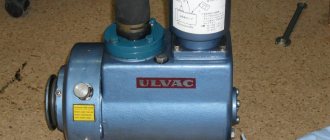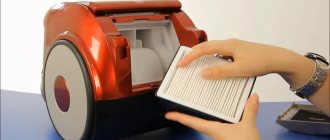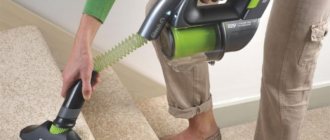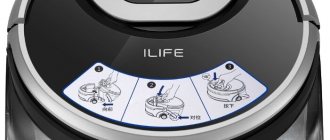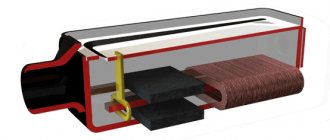Understanding how a vacuum cleaner works, its structure and the main differences between different designs of similar equipment makes the choice easier for a potential buyer. After all, its quality characteristics, consumer properties and maintenance rules depend on the operating principle and design features of the device.
All these points have been studied by us and described in detail in the article. The information presented will help you understand the specifics of the functioning of various types of vacuum cleaners, as well as choose the most suitable option among the variety of designs.
Device and design features
The design of the unit has not changed much over the past hundred years, nor has its performance. Having gone from an electric broom, a manually driven machine, to a gas-powered pneumatic carpet “renewer”, the vacuum cleaner technically settled on the James Spangler model.
An Ohio janitor has created a revolution by creating an upright and portable machine out of a broom, a pillowcase and an electric motor. Spangler's invention was sold under the Hoover brand. The modern device inherits the same design of the electrical part, brush and dust collector.
Hoover vacuum cleaners are the first to use aluminum in their housings. This happened around 1923
The main components of a conventional vacuum cleaner:
- Centrifugal compressor - creates a vacuum and pumps air.
- The commutator motor drives the compressor.
- Air purifier - separates dust from the air and collects it in special containers.
- A set of attachments and brushes for various purposes.
The device body itself is made of durable plastic. An engine, compressor, dust collector, filters, and control unit are built inside it.
The standard household design of a vacuum cleaner is equipped with a flexible air hose and extension tube. The exceptions are small-sized manual models and devices where the compressor is built into a tube with a nozzle or brush.
Any vacuum cleaner also has a three-level filtration system through which the sucked air is passed. It consists of a main, motor part and a fine filter (sometimes a container of water serves as a filter)
In order to expand the scope of application, manufacturers equip the devices with different attachments.
The universal one is always present in this set. It is designed for cleaning flat horizontal surfaces and carpets. The design includes switches, rollers for maneuverability, and brushes with different bristles.
The crevice nozzle is convenient for cleaning hard-to-reach places (corners, gaps, spaces between the wall and furniture). There are also collapsible 2-in-1 designs - universal plus a removable surface with pile
A separate variety is represented by turbo brushes, the structure of which allows you to collect wool and hair from carpets. Relatively recently, electric brushes, cylindrical rollers, nozzles for parquet, metal debris, cleaning siphons and others have appeared.
Performance based on performance
When purchasing a device, you should pay attention to 3 main characteristics of the device:
- engine power;
- suction power;
- filtration system.
It is important to distinguish the power of the entire vacuum cleaner from the suction power. The first indicator means the amount of electricity that the unit will consume during operation. The average for ordinary vacuum cleaners used for domestic purposes is 1300-2000 W. Most consumers associate power consumption and the quality of the device's performance, but this is a false argument. Products of different brands with the same engine power ratings may perform differently. Several factors influence the cleanliness of cleaning.
It should be taken into account that the power of the device is distributed among all additional functions with which the device will be equipped.
The suction power determines the quality of the output result. The stronger it is, the more dirt the vacuum cleaner can absorb. Devices with high suction will be able to clean bulky lint and large dirty stains. The speed of cleaning performed depends on this indicator. The average power is 250 W. With this vacuum cleaner you can slowly clean your living space and remove dirt. For faster cleaning in highly contaminated conditions, a 300 W device is better suited. For fans of turbo brushes, models with a rating of 350 W are suitable. When choosing a suitable product, you should correlate these 2 powers.
The device must have a decent suction rate, while consuming as little electricity as possible.
As for the filtration system, it also plays an important role in the operation of the unit. It is important not only to collect dust and dirt from the upholstery and lint, but also to leave it in the device without releasing it back into the room. This indicator is measured in the amount of dust contained in 1 m³ of space. Even 1% of dust can contain enough bacteria and allergens to cause an allergic reaction or harm the body. This is especially true in families with small children and pets. The optimal filtration rate is 99.97%. This level is considered the minimum to ensure clean indoor air.
How do different types of devices work?
All vacuum cleaners perform one function - cleaning. Why do devices, invented and manufactured with a single purpose, differ so much from each other in shape, size, and principle of operation?
When you first get acquainted with the device, the location of the dust collector, the number of wheels, or the material from which the hoses are made do not seem important. Understanding the significance of each detail comes during operation.
Let us analyze the design features and operating principle of the devices depending on the types of dust collector and the functionality of the devices.
Vacuum cleaner with bag or container
Schematically, the operating principle of this device can be represented as follows. Through the nozzle and hose, dust-filled air enters the device, namely into the dust collector - a bag or cyclone filter.
In a vacuum cleaner with a container, the garbage first falls not into a bag, but into a special centrifuge container, where large fractions are retained
Then one part of the dirt remains in the container, the other moves through the pores and vortex flows of the storage tank towards the motor. To protect it, a coarse filter was invented.
But it is not ideal either - the dirt travels to the outlet and approaches the fine filter (HEPA).
Compact vertical units
The peculiarity of this design is the absence of a hose. It is sometimes included in the kit and can be used to perform individual manipulations. The role of the main dust absorber goes to the brush - turbo or “beater”.
Modern vertical devices can interface with smartphones, thanks to which the owner can programmatically adjust the suction power, see how many kilometers the home assistant has traveled and other information
The motor and dust collector in the device are located in a pipe - the body of the unit. The motor does not so much create suction force as it rotates the brush shaft. In this case, the garbage seems to be “swept” into the dust collector.
Vertical models also have a suction module. But it is used when the device is used as a horizontal one.
Water filtered design
Vacuum cleaners with an aqua filter provide a different method of cleaning the incoming air, hence the structural features. The device is externally similar to a conventional container-type vacuum cleaner - it includes a nozzle and a hose, from which debris falls into the dust collector-aquafilter.
But the latter is made in the shape of a flask with water. The engineers' idea is for debris and dirt to sink under the influence of vortex flows.
What creates these flows? A turbine or separator rotating inside the flask. This visible part of the engine swirls dust and creates high pressure. The latter “captures” particles regardless of size, immerses them in water and does not give them a chance to get out.
In such devices, the shape of the turbine and its rotation speed are important. Manufacturers still have to add filters to designs that are not technically well thought out. The statement applies to budget separator models.
In a device with a Krausen aquafilter, dust moves through the pipe (1) into the aquafilter (2), then the separator (3) creates water-vortex flows (4) and reaches the ideal air purification coefficient (5)
These vacuum cleaners cannot be called completely filterless either, because they contain a protective filter for the motor. Only German engineers managed to get rid of it, who “sewed up” the motor into a stainless steel capsule. In this case, the motor is securely protected from dust and wet dirt.
Complex built-in modifications
These devices are not portable and are mostly mounted inside the walls. Their nozzles and hoses are not connected to the body of the vacuum cleaner, but are inserted into pneumatic sockets located throughout the intended operation area of the device.
Built-in vacuum cleaners are not very common in everyday life due to the need to use long hoses, which makes it difficult to perform comprehensive cleaning of premises.
A complex chain of air ducts is installed in the walls, through which the collected waste is directed to a common dust collector. The latter is located in utility rooms or in the basement, if available.
The unit itself includes both the engine and filters. The power plant is also often located in utility rooms.
Classification of vacuum cleaners by type of placement
There are horizontal, vertical, built-in and floor-standing devices.
Horizontal devices are equipped with wheels for transportation around the room. They are aggregated with containers for collecting waste, as well as engines and compressors, and come in 2 types - for dry and wet cleaning.
Floor types are designed according to the classic model. The dust collection container and the mechanism that collects dirt are connected to the body with a tube or flexible hose. In older models with a simple structure, there are metal components in a durable braid. The vacuum cleaner also includes reliable plastic pipes and hoses.
Vertical models are structurally very different from classic models, but the principle of operation of the vacuum cleaner is simple. For example, they don't have a hose. They are produced in the form of compact devices, inside of which there is a motor and a container for collecting dirt and dust with a filter. The nozzles are equipped externally to the body and can be stationary or removable. Modern models are wireless and equipped with a rechargeable battery. The brush effectively picks up dust and hair, which pet owners will love.
Built-in appliances are not popular because their design is complex. They consist of channels that are installed along the perimeter of a residential building in the walls. The corrugated composite hose and pipe are attached to the fittings on the surface, and the motor and dust collector are mounted in the closet. Hoses make it difficult to clean the house. Therefore, they are not suitable for residential premises.
Features of washing machine models
The main design difference between washing machines and models with a bag and container is the presence of a reservoir for clean and dirty water. Small and large fractions of dirt sink in such a container.
The main advantage of such a tank is that the owner does not have to breathe dust while emptying the tank.
The design of the washing vacuum cleaner has an additional reservoir for water and detergent, a pump, liquid supply channels integrated into hoses and tubes
But the design of washing vacuum cleaners also includes protection of the motor from moisture, which significantly increases the cost of the vacuum cleaner. And wet dirt accumulates on the HEPA filter, which creates a breeding ground for many bacteria.
There are washing vacuum cleaners with a steam generator. This device allows you to clean surfaces with steam without the use of chemicals.
Additional functionality
Additional functionality usually includes the possibility of reverse operation of the engine impeller, that is, not for suction, but for blowing. This option allows you to remove dust and small debris from hard-to-reach places and crevices, so you can then clean it up as usual. Also, in addition to the basic functionality characteristic of each of the above types, vacuum cleaners may have the following additional convenient features:
- start blocking – triggered if there is no dust collector in the case;
- indication of filter contamination—relieves the user of constant physical monitoring;
- automatic shutdown - activated when the garbage container is fully loaded;
- dust bin full indication – signals when you need to empty the container or insert a new bag;
- overheating protection – provides for turning off the engine until it cools down;
- soft start – designed to prevent overloads;
- automatic adjustment of water (steam) supply – relevant for washing/steam devices;
- automatic rewinding of the power cord - saves time when cleaning;
- adjusting the length of the network cable - involves automatic unwinding/rewinding of the wire during the cleaning process as needed;
- aromatization - some models have a special compartment for aromatic plates or granules;
- bactericidal lamp – automatically disinfects the surface being cleaned;
- rubber bumper – protects furniture and the vacuum cleaner body from damage when colliding;
- shoulder strap – relevant for hand-held devices.
So, the variety of vacuum cleaners on the modern market allows you to choose a model to suit the most unexpected requirements for both home and industrial use. Depending on the form factor, the technical capabilities also differ, although the operating principle of all vacuum cleaners remains the same. Additional functionality expands the range of applications of the devices and simplifies interaction with them during daily use.
High-tech robotic vacuum cleaners
Robot vacuum cleaners only appeared about 10 years ago. Their designs are constantly updated and improved. The devices are created according to a block design. This ensures ease of maintenance and ease of replacement of parts during repairs.
Common elements of a robot vacuum cleaner that are found in all models:
- side brush;
- block module;
- charging base;
- sensors for detecting obstacles, pollution, height differences.
The operation of such a device is based on a cleaning unit, navigation, drive mechanisms and a battery device.
Gadget navigation systems
The state-of-the-art navigation system consists of a laser, camera, internal and external sensors. The camera reads a map of the room. Rangefinder lasers transmit information to her about the presence of objects in the room and the distances between them.
The device moves in straight lines both during cleaning and during the process of returning to the base.
Robot vacuum cleaners do not yet know how to go down stairs or overcome high thresholds. Developers are trying to eliminate this defect in gadgets by inventing new models.
There are still models on sale whose operating principle is based only on sensors. They are located on the outer body of the device and inside it.
With their help, the robot navigates in space and adjusts its work, and also notices the most contaminated areas and is more careful in cleaning them.
Magnetic tape can also be used to navigate the robot. It creates a virtual barrier beyond which the device does not move. If the cleaner is equipped with a camera, it takes readings from the ceiling and walls.
Cleaning process
Here, the models differ in types of cleaning - dry cleaning and washing robotic vacuum cleaners. In the first, the side brush picks up all the dirt and directs it to the central brush. The central one has a fleecy surface and is capable of collecting hair and wool.
The design of the front brush of the robot is installed with an inclination into the device, and the side one has flexible wires, which ensures thorough collection of debris
Then these two parts send the garbage to the dust collector, where it is compressed by air currents. And the air passes through the filters to the outside.
Depending on the manufacturer, robot designs differ in the following nuances:
- Basic brushes . Most models have two of them - fleece and rubber. They work in pairs. Some devices are equipped only with rubber.
- Side brushes . There are devices that have an additional side brush built into them.
- Filters . The robots are equipped with both standard “napkins” and multilayer HEPA.
- Container + engine power . The waste collection container can have a volume from 0.4 to 1 liter. The power of such devices is 40-65 watts. If the first numbers are important during operation, then the second ones are unimportant due to the small range.
The main consumer part of robotic vacuum cleaners is the main brush. The quality of cleaning depends on it, and not on the engine, as with conventional units.
A wet vacuum cleaner has in its design a system of a water tank and a sprinkler. It can collect debris, spray liquid, polish the floor and collect dirty water back into the reservoir.
There are robot models designed for mixed cleaning. The principle of their operation is to clean smooth surfaces with a rag, and carpet surfaces with basic brushes.
Return to base
The final stage of the robot’s work is its return to the mother base. The device is powered by batteries. If they are discharged, the device turns off.
There are robots with a program that leaves the device at the cleaning site, and the user forces the return to the base
The device automatically reacts to a low charge percentage. Using a special sensor, it detects an infrared beam from the base and begins to move towards it. As soon as it finds it, it docks with it and charges.
Modern vacuum cleaner – what is it?
This is a device that guarantees high-quality and comfortable cleaning.
Its main characteristic is power consumption, which for new models is 1.2-2.5 thousand watts. The suction power, reaching 400 aW, is also important, as well as the number of filters, dust collector capacity, size and weight. In Russia, models with low power consumption that save electricity are sold. Additional Information! New vacuum cleaners operate quietly. The noise of the quietest of them is 75 decibels, and the noisiest - 95-100 dB.
Vacuum cleaner at work: principle of operation
In a traditional vacuum cleaner, after starting the engine, a draft appears, with the help of which dirt and debris are sucked through a hose that has a nozzle that lifts the lint and pulls out dirt from the surface. Along with the air currents, dirt falls into a separate container (usually a bag). The built-in filter purifies the air and returns it back.
Important! To learn how a vacuum cleaner works, you need to become familiar with air filtration, because this is the most important process. In cheap models, the air is poorly purified and the device begins to generate dust. Therefore, it is better not to save on it.
Constructive details and quality of cleaning
Some design features of the device affect the quality of cleaning and ease of use. For example, a hose. It must be of sufficient diameter (at least 5 cm) so that it does not become clogged frequently.
The length of the flexible hose is important - the longer this accessory, the more convenient it is to clean. Especially in rooms of 15 square meters. and more. A length of 2.5 m is needed for cleaning high furniture and ceilings
The strength of the material is also important, otherwise the part will crack, which will reduce the suction power.
In addition to the main components, the quality of operation of the device is also influenced by seals, bushings, and bearings. If the joints are made of fluoropolymers, this ensures their tightness.
Bushings and bearings made of fluoroplastic and polyamide extend the life of the moving parts of the device.
Additional information about different types of vacuum cleaners, as well as tips on choosing the right unit, is provided in this article.
How does a vacuum cleaner work?
It’s hard to imagine that the “great-grandfather” of the modern vacuum cleaner was born back in 1907. It was built by the American inventor James Murray Spangler, who had previously received patents for several other units. His portable vacuum cleaner consisted of a fan, a sewing machine motor, a pillow cover begged from his wife, and a rotating brush. However, he did not have the means to establish mass production, which was taken advantage of by his cousin’s husband, William Hoover, who bought the patent.
Enough water has passed under the bridge since then, but vacuum cleaners have not undergone any revolutionary changes. A modern device consists of several elements. The “heart” of the device is a motor, consisting of two parts: an asynchronous commutator motor and a fan rotor mounted on a shaft. Other nodes and elements:
- frame;
- dust collector;
- a set of nozzles, brushes;
- extension pipe;
- air hose;
- filter (or filter system).
The body is made of high-strength plastic. There are two types of dust collectors: bags and containers. The number of attachments may vary, it all depends on the configuration of a particular model. For example, universal brushes are almost always available, but, on the contrary, not every vacuum cleaner is equipped with convenient, effective turbo brushes.
Conclusions and useful video on the topic
Analysis of the design and operating principle of a vacuum cleaner with pressure sensors and two electric motors - in the brush and the body of the device.
The examples of several designs of vacuum cleaners clearly show that, regardless of the type, they all serve equally as “dust cleaners.” Their effectiveness depends on the filtration system, engine power, and the presence of various nozzles.
Which vacuum cleaner did you choose for your home or apartment? Please tell us why you chose a particular model, and whether you are satisfied with the performance of the purchased equipment. Add reviews, comments and ask questions - the contact form is below.
The history of the vacuum cleaner
The first vacuum cleaner had little resemblance to a modern device. To operate such an invention, two people were required at the same time.
This is interesting! The principle of operation of the first vacuum cleaner was to blow up dust, not collect it.
In 1901, engineer Hubertan Cecil Booth created a device that sucked up dust. It did not work from the network, but on a gasoline engine.
In 1908, a mains-powered vacuum cleaner was released.
In 1912, a fan was installed in the vacuum cleaner instead of an air pump.
The end of the 20th century saw the creation of new models of vacuum cleaners with wet cleaning capabilities (washing vacuum cleaners).
And in 2002, a robot vacuum cleaner was created for the first time.
Cleaning attachments
Quite popular and most functional attachments: – for floors and carpets; – turbo brush; – crevice nozzle; – brush attachment; – electrostatic brush; – vacuum nozzle.
For quick and high-quality cleaning, it is enough to have several attachments. As practice shows, few people use most attachments (even if they are included).
Popular models
You can check out the best models according to Yandex. Market, which have earned unequivocal praise in the reviews of all their owners. Perhaps this will help you finally decide, and you will come to the store with clearly formed and formulated desires. To facilitate perception and comparison, descriptions of the models are presented in the table. The prices listed are indicative.
Table: best Samsung vacuum cleaner models
| № | Model name | Vacuum cleaner type | Dust container type | Filter type | Dust container capacity, l | Suction power, W | Power consumption, W | Noise level, dB | Weight, kg | Price, rubles |
| 1 | VC15K4130HB | ordinary | container (cyclone filter, AntiTangle turbine) | HEPA H13 | 1,3 | 390 | 1500 | 86 | 4,6 | 8490 |
| 2 | VC21K5150HP | ordinary | container (cyclone filter, AntiTangle turbine) | HEPA H13 | 2 | 440 | 2100 | 84 | 7,6 | 11430 |
| 3 | VS60K6030 | 2-in-1 (vertical + manual) | container (cyclone filter) | HEPA H13 | 0,25 | 30 | 170 | 83 | 2,8 | 13450 |
| 4 | VR10M7030WW | robot | container (cyclone filter) | exhaust and engine filters | 0,3 | 10 | 80 | 72 | 4 | 31890 |
| 5 | VR20H9050UW | robot | container (cyclone filter) | exhaust and engine filters | 0,7 | 30 | 70 | 76 | 4,8 | 42982 |
Sequence of work
- The device is disconnected from the power supply.
- Disconnect the hose from the body (while carefully checking the holes for clogging).
- Unscrew all connecting screws, including screws hidden under buttons and other removable parts (for convenience, it is better to put all small parts in a separate, stable container).
- Carefully remove the housing cover.
- Take out the dust container and remove all filters.
- Carefully inspect each element separately: darkening of the filter materials indicates the need for replacement or cleaning (possibly washing for sponge filters); You will also need to thoroughly blow and remove dust from all accessible components (you can use another vacuum cleaner with a special blowing nozzle).
After a thorough inspection of all working mechanisms and careful cleaning of internal contaminants, the structure is reconnected. The question of how to assemble a Samsung vacuum cleaner usually does not cause any difficulties, because the process is completely opposite to the previous one. Especially if all the parts from disassembly are laid out carefully and alternately into accessory groups. You can capture the process step by step in advance so that you can easily put everything back together.
If you follow simple care rules, a high-quality Samsung vacuum cleaner will last a very long time, making the life of the modern user much easier, because with a high-quality device it is possible to quickly and easily clean your entire home, creating a clean and comfortable home.
Important details in the design of vacuum cleaners
The high-quality operation of a vacuum cleaner is determined primarily by the functioning of the main components. But the design of cleaning units contains a large number of parts that are not very important at first glance, the condition of which determines the service life of the vacuum cleaner, suction power and degree of air purification. These include:
- filters;
- seals;
- bushings and bearings.
Filters made from modern woven and non-woven materials help to obtain the outgoing air stream as clean as possible from dust and biological contaminants. The use of fluoropolymers to seal joints ensures the tightness of various functional areas of the vacuum cleaner. Polyamide and fluoroplastic bushings and bearings extend the trouble-free operation of moving and rotating parts.
Installation and installation
Ideally, a centralized vacuum cleaner system is installed during the construction or major renovation stage. Otherwise, you will have to use plasterboard structures, decorative stucco or a suspended ceiling. It is customary to place the power unit in a pantry, basement, garage or even on a loggia, if possible. Pipes and sockets are mounted in the wall or ceiling. In the kitchen, you can try placing air inlets directly inside the furniture set.
First of all, the power unit is installed, then the air exhaust going to the street and pipe routing are worked out. Afterwards, you can work on the pneumatic inlets and pneumatic scoops in the necessary rooms. Having connected the power unit, you will first have to check the tightness of the system, and then you can check the operation along with the hoses. The sockets are placed so that it is easy to approach them and secure the hose, and they can only open upward. It is customary to install one copy per 30 or 70 square meters.
It is better to move the central apparatus away from residential areas and be sure to ensure that a 30-centimeter free zone is formed on all sides of it.
In the next video you will see the installation of the Electrolux BEAM SC335EA built-in vacuum cleaner.
Kinds
Models of built-in vacuum cleaners have some differences depending on the room for which they are intended. For example, a unit that serves only the kitchen may be a stationary structure built either into the walls or into the furniture. Since there is no need for a functioning pipe system, the power of the device itself increases significantly. The washing central vacuum cleaner allows you to carry out wet cleaning using a separator. By connecting this part on one side to the cleaning hose, and on the other to the hose going to the air socket, you will be able to suck in not only dry dirt, but also liquid.
Washing units are indispensable for cleaning furniture, cars, as well as carpets and even fireplaces. After completing the work, the system will have to be disassembled, washed and dried. A built-in vacuum cleaner of a plinth type is also called a pneumatic scoop, and its operation was described above.
Advantages and disadvantages
Based on the above features and operating principle, you can compare which vacuum cleaner is better - with or without a bag. To do this, let's look at the advantages and disadvantages of different models.
The main advantages and disadvantages of vacuum cleaners with an aqua filter.
| Advantages | Flaws |
| High-quality cleaning of floors from dust and debris. | High price. |
| No need to buy additional filter bags. | Large dimensions and weight, especially when filling the tank with water. |
| The power and suction strength do not depend on the degree of contamination of the container. | The need to disassemble the vacuum cleaner after each cleaning in order to wash and dry the water container, as well as the entire structure. |
| An additional result is air washing and humidification at the outlet. | More noise |
Cyclone types of vacuum cleaners also have their advantages and disadvantages.
| Advantages | Flaws |
| Relatively low price. | The need to frequently wash and change filters. |
| The device does not require additional purchase of filter bags. | In budget models, air filtration is much worse than in bag-type devices. |
| Debris can be easily removed from the flask. | The suction power is inferior to bag models. |
| The suction power does not depend on the filling of the container. | After each cleaning, the container must be emptied. |
What other vacuum cleaners are there?
The types of vacuum cleaners listed are not the entire range of possible options.
Robot vacuum cleaners
Progress does not stand still and robotic vacuum cleaners are gaining more and more popularity among consumers. An innovative type of equipment allows you to clean the room without the participation of the hostess.
This vacuum cleaner model is:
- A device in the form of a disk powered by batteries.
- The diameter of the disk is 25-35 cm, and the height of such a vacuum cleaner does not exceed 13 cm.
- Cleaning brushes are located on the bottom and sides of the device.
- The robot is equipped with a 3-4 stage filtration system.
Models of modern technology are equipped with many functions:
- they can perform cleaning along a programmed route a specified number of times;
- are able to remove dust and debris not only from a flat surface, but also under armchairs, tables and chairs;
- can unload dust into a container, etc.
However, this miracle technology also has its disadvantages, in particular:
- Low efficiency.
- Possibility of getting stuck.
- Doesn't move well on carpet.
Vacuum cleaner with steam cleaner
A device in the form of a mop with a steam cleaner is a very compact cleaning unit. In appearance, the vacuum cleaner really resembles a mop, but instead of a rag, this device uses a special steam nozzle.
The design of the vacuum cleaner is similar to that of washing models. The only difference is the steam generator installed in the housing.
Thanks to the large number of attachments, cleaning becomes a snap; in addition, with the help of steam you can disinfect any things and any surfaces. You will find different models of this group in the comparative review “Vacuum cleaners with steam cleaners”.
However, this technique has its disadvantages:
- Sudden temperature changes negatively affect fabric, tiles and stone.
- Higher cost, compared even to washing models.
- Fragility.
- Limited opportunities.
The first vacuum cleaner - legends and reality
It is unlikely that today you can find a person who does not have a vacuum cleaner in his household, a faithful friend and reliable assistant in the struggle for order and cleanliness.
Like almost every technical device created for the benefit of people, this device has its own interesting history. According to one noteworthy version, the very first vacuum cleaner in the world appeared in the mid-19th century in Chicago.
Its inventor, Daniel Hess, patented his invention, which at that time was a fairly simple mechanical device controlled manually. The device was equipped with two brushes rotating around its own axis and bellows creating an air flow. The collected dust settled in chambers with water. Thus, the first vacuum cleaner in the world was an analogue of modern washing models.
Working with this clumsy device took a lot of energy from the cleaner, since he had to not only carry a heavy unit, but also constantly turn the pump handle, without which the device would not perform its main functions. Due to the inconvenience of use, the mechanical dust collector has not become widespread. In addition, a huge fire in Chicago destroyed all the stocks of these devices prepared for sale.
According to the official version, the first patent for a vacuum cleaner was received by the English inventor Hubert Cecil Booth. It was he who came up with the idea of collecting dust with a special machine, a working model of which was first presented in 1901. The first vacuum cleaner looked so bulky that one can only admire the incredible evolution that has occurred with this device over several decades. Today, arguing about who invented the first vacuum cleaner seems pointless. The main thing is that this brilliant miracle of technology has appeared in our everyday life, capable of real feats in the eternal war of man against dirt.
Features of application
The service life and efficiency of use depend largely on how correctly you use the device and how you care for it.
To ensure that your vacuum cleaner lasts as long as possible, read the reviews and take into account the recommendations of those who have already purchased the same model.
When using this technique, it is worth remembering that it is intended for dry cleaning and cleaning only. Its advantage is the absence of the need to regularly clean the equipment. The container is cleaned and washed only when it becomes dirty; however, care should not be delayed in order to reduce the back emission of dust to a minimum.
When choosing one option or another, give preference to trusted manufacturing companies that are widely known in the market and have a good reputation. In order for the vacuum cleaner to work for a long time and without hitches, you should use it correctly according to the instructions.

